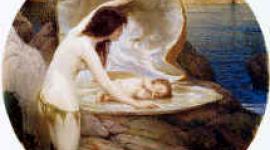A Celtic Response to An Inconvenient Truth

With a growing interest in Celtic Christianity, one might ask why would a 7th Century faith be relevant to a 21st Century world. Put more directly: how would a 7th Century Celt respond to the predicament of 21st Century man faced with global warming? And if this ancient individual were magically transported to the 21st Century, what would he think of the movie "An Inconvenient Truth"?
In all likelihood he would be dismayed and saddened. He would be dismayed that a spiritual world had been so thoroughly displaced by a material world. He would be saddened that the significance of creation had been so totally lost. He would wonder how reverence for a natural world had been completely forgotten. He would ask, "Had modern man no appreciation for any of God's creatures, himself included?" To understand this "older world view", it is necessary to step back a few thousand years.
continue story below
Several centuries before the birth of Christ, Celtic territory extended all across continental Europe and into what is now Asia. By the time of the 2nd Century AD, this territory was reduced to the British Isles. Pushed relentlessly westward by the Roman Army, the Celts could only claim these remaining islands. Oddly, it was here that initial Celtic contact with Christianity occurred, provided by a few Roman soldiers who were Christians themselves. Except for the missionary work of St. Alban in the 3rd Century, no further Roman presence would occur for another 300 years. The Celtic church would develop in isolation, influenced only by local custom and tradition. These would leave traces of Druid mysticism, a genuine reverence for the natural world, and a strong sense of interconnectedness between the seen and unseen worlds.
Late in the 4th Century, the first Celtic theologian Pelagius would develop Celtic beliefs a bit further. Significantly, that:
-
Christ commanded man to love not only his human neighbor, but all life forms.
-
Christ was the perfect fulfillment of wisdom and humility, and what mattered more than believing in him was becoming like him.
-
Every child was conceived and born in the image of God - the embodiment of the original unsullied goodness of creation. This did not deny that man was capable of sin, only that sin masked man's essential goodness. Redemption, as offered through Christ, liberated man from his "failures" and returned him to his fundamental goodness.
During the time of St. Patrick, circa 430, new aspects of Celtic Christianity emerged. These included a sense of the Goodness of Creation, an awareness of heaven's presence on earth, and creation of endlessly interwoven designs representing the inter-relatedness of spiritual and material realms, of heaven and earth, and of time and eternity. Ultimately these found expression in the high crosses of Iona, the glorious illustrations of the Lindesfarne Gospels, and countless hymns and prayers.
There existed also an extraordinary desire to integrate the gospel with the older Celtic traditions. Rather than discard these older beliefs, the Celts merged them with newer Christian ones. They welcomed a gospel that offered hope of an eternal life, and a living spirit that was not confined to matter alone. They allowed the gospel to do its transforming work, and in the process found the fulfillment of their older Celtic mythologies.
The gospel of St. John the Evangelist was particularly significant. It represented the heart of Celtic Christianity. Rich in metaphors (expressed as "Light" and "Word" and "Stillness"), this gospel appealed to Celtic imagination and spirituality. Their special love for St. John was their memory of him leaning against Jesus at the last supper. It is said that St. John heard the heart beat of God. The related imagery of stillness and listening, of heart and Love, became central to the Celtic understanding of the word of God.
Likewise the Creation Stories were seen as an expression of God's Goodness in all aspects of the natural world. It is here that the truth of God is revealed. Not hidden away, it's found deep within all that has life. In God's Creation, all creatures are equal, and all that God has created is good. God's command to "Be still and know that I am God" is a command to appreciate the natural world, to listen to the words of the heart, and to see the goodness creation offers. Mankind is not an alien to the natural world; he is a part of it. If he loves not the natural world, then he loves not his neighbor, and he loves not God.
Columba's arrival to the Isle of Iona in 563 was the final phase of Celtic Christianity. It represented a restlessness to go to wilderness areas - a place to be tested, to be upset, a place to find one's self. Iona was not only a wilderness place, but also "A Thin Place" where the sky and sea and land came together. It was a place where the seen and unseen worlds met one another, and a place where a deeper meaning to life might be found. Iona also represented the culmination of a pilgrimage and a chance encounter with the unknown. Without maps or destination, Columba set out from Ireland, rudderless, and adrift on the sea. By chance he landed at Iona. His journey imitated the homeless journey of Christ and His disciples, wandering about the wider world, totally dependent on the world's hospitality. By setting out on similar journeys, he and others discovered how small and insular their world could be. Determined to get themselves beyond these boundaries, they continuously pushed at the edges, moving physically outwards in one direction, but spiritually inwards in another toward wholeness.
Celts also had a wonderful sense of companionship with Jesus. "He was a great reminder of what it is to be fully human: fully here in human life, fully here to the world around us, and fully present to the unseen worlds, able to go back and forth through the doorway where the worlds meet." To the Celtic world, Iona was one such place - a doorway where the worlds meet, where one could experience the presence of Jesus.
By mid 7th Century, Celtic beliefs created significant tension between the Roman Church and themselves. The minor differences over tonsure and the celebration of Easter had become insurmountable. Celtic Christianity had moved significantly further away from its counter part in Rome. Where the Celtic Church was monastic, without central organization and focused on the Goodness of Man, the Roman Church by contrast was hierarchical, institutionalized with ever-increasing papal authority, and heavily influenced by the Augustinian doctrine of Man's Depravity and Fall from Grace. At the Synod of Whitby in 664, the collision finally occurred. King Oswy, a Celtic Christian, was faced with a momentous decision: Would his Kingdom practice Celtic Christianity or Roman Christianity. He chose in favor of the Roman tradition. From that point forward Celtic Christianity experienced a slow decline. By the 12th Century it had become little more than an oral tradition.
However, in outlying areas of Scotland and Ireland, prayers and hymns continued as a part of daily life. In the mid 19th Century Alexander Carmichael collected and published those that he could find in a volume entitled Carmina Gadelica. At the same time, author George MacDonald began writing short stories and novels that reflected the essence of Celtic spirituality. In the early 20th Century, the influence of George MacLeod (a Presbyterian Minister) brought Celtic Christianity into the mainstream of British Christianity. "He taught that we should not look away from the material world in some spiritual realm but rather more deeply in the life of the world. The spiritual is not opposed to the physical, he believed. For God is to be found in the material realm of creation, not in escape from it." Ultimately this earlier heresy had come full circle. It now was acceptable doctrine.
continue story below
In 1938, MacLeod made the decision to rebuild the Abbey at Iona, the place where Columba had first landed nearly 1400 years earlier. This marked the re-emergence of Celtic Christianity in a very tangible way.
Today, tens of thousands visit the Isle of Iona just to glimpse this venerable place, to pilgrimage around the island, and to experience the mystery of an ancient faith made new. And, if they listen carefully, they may hear an ageless response to An Inconvenient Truth, or perhaps, more poignant, this prayer offered on behalf of mankind.
Give me a candle of the
spirit, O God, as I go
down into the deep of
my own being.
Show me the hidden things.
Take me down to the spring
of my life and tell me my
nature and my name.
Give me freedom to grow so
that I may become my true
self----
the fulfillment of the seed
which you planted in me at
my making.
Out of the deep I cry unto
thee, O God. Amen
APA Reference
Staff, H.
(2008, December 13). A Celtic Response to An Inconvenient Truth, HealthyPlace. Retrieved
on 2025, November 29 from https://www.healthyplace.com/alternative-mental-health/sageplace/a-celtic-response-to-an-inconvenient-truth

